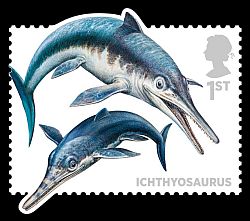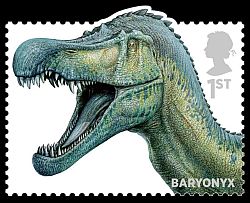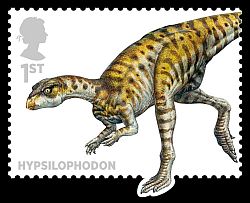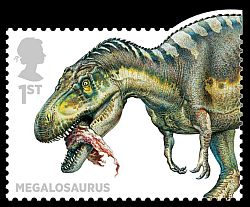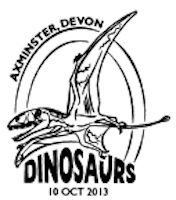| Issue
Date |
10.10.2013 |
| ID |
Michel:
Stanley Gibbons: UPU:
Category: pR |
| Author |
Design
Why Not Associates
Illustration John Sibbickl Consultant Angela
Milner |
| Stamps
in set |
10 |
| Value |
1st
calss (GBP
0.60) x10
1st Class - Polacanthus
1st Class - Ichthyosaurus
1st Class - Iguanodon
1st Class - Ornithocheirus
1st Class - Baryonyx
1st Class - Dimorphodon
1st Class - Hypsilophodon
1st Class - Cetiosaurus
1st Class - Megalosaurus
1st Class - Plesiosaurus
|
| Size
(width x height) |
37mm x
27mm excluding protrusions |
| Layout |
2
stripes of 5 stamp each, issued in sheets of 25 and
50 stamps
|
| Products |
FDC x 1
PP x1 Gutters x1
Special Cover x1 |
| Paper |
Phosphor:
all over
Gum: self-adhesive |
| Perforation |
13.5 x
14 |
| Print
Technique |
Gravure
|
| Printed
by |
Walsall
Security Printers |
| Quantity |
|
| Issuing
Authority |
Royal
Mail
|

On October 10, 2013 Royal
Mail,
first time since
1991,
launched a set of ten
self adhesive stamp of "Dinosaurs" (actually four
animals depicting in these stamps are not dinosaurs,
but flying and marine reptilies: Dimorphodon
Ornithocheirus,
Ichthyosaurus, Plesiosaurus ). The new stamp
collection is designed to celebrate the 200 year history of paleontology in Britain
and the discovery of a multitude of dinosaur remains in Britain by
British paleontologists.
Dinosaurs have often been associated with North America and
the exploration of the Wild West that began in the 1870s, but as mentioned
above the earliest discoveries of dinosaurs and their contemporary marine and flying
reptiles happened in England during the early 1800s. The dinosaurs in
this 10-stamp set have strong connections with the following locations
in Great Britain:
LYME
REGIS - DORSET
The cliffs and foreshore are the world’s most important and famous sites
for marine reptiles that lived 201-195 million years ago.
ICHTYOSAURUS
and
PLESIOSAURUS
swam in the shallow seas that covered Dorset. The pterosaur
DIMORPHODON
flew over the water and occasionally
fell in.
OXFORDSHIRE
MEGALOSAURUS,
the first dinosaur to be named, came from Stonesfield Quarry near Witney.
CETIOSAURUS was
discovered in several locations during the 19th century, including
Chipping Norton and Bletchington Station, notable for the most complete
skeleton found.
OCKLEY
- SURREY
The
only fairly complete skeleton of the fish-eating dinosaur,
BARYONYX,
was discovered in a working brick-making clay pit at Wallis Wood, near
Dorking, in 1983. Remains of
IGUANODON
and a SAUROPOD have also been
uncovered there.
TILGATE
FOREST - WEST SUSSEX
The first
recognised dinosaur fossils came from a stone quarry at Whiteman’s
Green, Cuckfield. They included teeth discovered in 1822 and
later named
IGUANODON.
Pterosaur fragments, originally identified as
birds and later as
ORNITHOCHEIRUS,
were also found there.
The fossils
from seven of the ten depicting dinosaurs have all previously been found
on the
Isle
of Wight,
many of which are on display at Dinosaur
Isle in
Sandown. Isle of
Wight palaeo-artist
John
Sibbick was
selected from a number of expert artists as he is one of the foremost
illustrators of dinosaurs and has decades of experience. It was felt
that Sibbick’s painterly approach gave a more detailed realisation of
the animals than tests with computer generated imagery at stamp size.
The stamp designs in this issue are printed such that the
creatures ‘break out’ of the self-adhesive stamp frame, so there is not
a clean straight edge to the stamp.
Mr.
Sibbick
said: "I always knew that designing and
illustrating stamps was a rigorous and painstaking process.
To get the opportunity was a dream come true, especially depicting the world famous dinosaurs found
on the
Isle
of Wight. To get such access to fossil dinosaur
bones, tracks and the plants in their environment on the Isle of Wight
makes the reconstruction process a much more vivid experience." The
museum will host an exhibition telling the story
of the creation of
John
Sibbick's work.The stamps have been
produced under the guidance of
palaeontologists from
the
Natural History Museum, including the
Angela
Milner. (who is along with
Alan
Charig, her colleague at the Natural History Museum in London, named and described
Baryonyx, one of the dinosaurs featured in the set. ) Each
illustration is anatomically correct to the extent of present
scientific knowledge.
The exciting Dinosaur
Island App Trail
based on the ancestral links between the characters in the film and the
dinosaurs
on the Isle of Wight,
will give you the chance to be seen standing alongside dinosaurs in the very place they were discovered.
The app utilises new technology which allows you to
use smart phones and tablets to take pictures of family and friends walking
alongside the dinosaurs that roamed the Isle of Wight 130 million years
ago, while at the same time learning more about their relatives - the
dinosaur characters in the movie. The Augmented Reality App is
available to download from anywhere in the world, but will only
be triggered into life at six
coastal locations on the Isle of Wight.
These
stamps presentation, to public for the first
time, took place at the Natural History Museum in London on
October 7, 2013 - few
days prior to official
release.
Broadcaster and
naturalist,
Sir David
Attenborough
said; “It was a
British scientist,
Sir Robert Owen,
the first Director of the Natural
History Museum, who first identified a dinosaur and who invented that
name for the whole group. The sheer size and variety of these extinct
reptiles captivates people of all ages and inspires children’s
imaginations. They are perennially popular and have inspired countless
books, films and television series. These stamps are a wonderful
reminder of the majestic creatures that once roamed what is now Great
Britain hundreds of millions of years ago.”
Dinosaurs dominated the
Earth for more than 160 million years during
the Mesozoic Era, 252 to 65 million years ago, often called the
Age
of
Dinosaurs.
They shared the planet with many other animals
including
marine reptiles,
ichthyosaurs and plesiosaurs, and flying reptiles
called pterosaurs. The first finds of all these ancient groups were
made in southern England in the early 1800s. Thus began our
ever-growing fascination with this long-lost world.
The
Ichthyosaurus, the Plesiosaurus and the Dimorphodon were all first
discovered by Mary
Anning (famous British fossil collector, dealer, and
paleontologist) on the beaches of Lyme Regis at the beginning
of the 19th century, and their fossilised remains can still be found
along the Jurassic Coast today.
Mary Anning and her brother
Joseph discovered the first ever Ichthyosaurus in 1811 on the beaches
between Lyme Regis and Charmouth. Mary continued to find fossilised
remains of the Ichthyosaurus during the next ten years, before
discovering the Plesiosaurus in the winter of 1828.
David
Tucker, curator at Lyme Regis museum, said he was delighted the Royal
Mail had commemorated Anning’s finds in the stamp collection, he
said “The collection is very interesting and shows the very
strong local connection in marine reptile fossil discovery and I’m
delighted they have chosen three of Anning’s discoveries. I will
certainly be getting some of the stamps, and I am very pleased to see
them.”
The stamp set was
originally
scheduled for release last year (2012), to mark the centenary of the
publication of ”The Lost World”, a novel by Sir Arthur Conan
Doyle
that tells the story of an exhibition to South America led by
Professor Challenger that discovers a whole host of prehistoric animals
surviving on a remote plateau. Ironically, a number of
animals
featured on the stamps such as the Iguanodon along with the Pterosaur
Dimorphodon and the marine reptiles are featured in this book. The
South American Spinosaurid Irritator, a dinosaur from the same branch
of the Theropoda family tree as Baryonyx has a link to Sir Arthur Conan
Doyle’s novel. The specific name for Irritator (Irritator
challengeri)
is a reference to Professor Challenger, the
central character in the book. Finaly the stamps launched end
of 2013, only two months prior to UK Premiere of WALKING
WITH DINOSAURS: THE 3D MOVIE
Some
more details
prehistoric animals depicting on the stamps:

|
Polacanthus - many spines
Period:
Early Cretaceous
Main
group: Dinosauria, Arikylosauria
Length:
4—5m
Weight:
1000-2000kg
Diet:
Plants
Discovered:
Reverend William Fox, Isie of Wight, 1865
Firts
described: Richard Owen, 1865
Known from only two partial skeletons, both lacking skulls, the heavily
armoured polacanthus (‘many spines’) was a herbivorous quadruped
protected against predators by spikes and studs along its body and a
heavy hip shield of flat, bony plates.
|
Ichthyosaurus - fish lizard
Period:
Early Jurassic
Main
Group: Icthyosauria
Length:
2m
Weight:
80—100kg
Diet:
fish and squid
Discovered:
Joseph and Mary Anning, Lyme Regis, Dorset,1811
Firts
Described: Everard Home, 1814
Adapted to life in the sea, the Ichthyosaurus
breathed air and gave
birth to live young in the water. About the size of
a modern
dolphin, but with vertical rather than horizontal tail flukes, it ate
fish and squid.
|
|
Period:
early cretaceous
Main
group: Dinosauria,
Omithupoda
Length:
10m
Weight:
4000-5000kg
Diet:
plants
Discovered:
Gideon Mantell, Tiigate Forest, West Sussex, 1822
First
described: Gideon Mantell, 1825
With forelimbs which were much shorter than its
hind limbs, iguanodon (‘iguana tooth’) was a herbivore that could stand
or walk on all fours but ran bipedally. Its distinctive thumb spikes
might have been for defence or for foraging.
|
Ornithocheirus - bird hand
Period:
early cretaceous
Main
group: pterosauria
Length:
2.5—3m wingspan
Weight:
4—5kg
Diet:
fish
Discovered:
Tilgate Forest, West Sussex, 1827
First
described: Harry Govier Seeley, 1869
The lightweight ornithocheirus (‘bird hand’)
flew by soaring and gliding on its long, narrow wings, and fed by
skimming the surface of the sea to catch fish in slender jaws which
were fringed with outwardly-pointing, interlocking teeth.
Ornithocheirus represents the pterodactyloid
pterosaurs. This species was first described by Harry Govier Seeley in
1869, though the fossils had been known of since 1827.
|
|
Period:
Early Cretaceous
Main
group: Dinosauria, Theropoda
Length:
10.5m
Weight:
2000kg
Diet:
fish and other dinosaurs
Discovered:
William Walker, Ockley, Surrey, 1983
First
described: Alan Charig and Angela Milner, 1986
Baryonyx (‘heavy claw’) was a
land-based fish-eating creature with a long snout full of serrated
teeth. It had a huge thumb claw covered by a horny sheath, which may
have helped it catch its prey.
|
Dimorphodon - two form tooth
Period:
early jurassic
Main
group: Pterosauria
Length:
1m wingspan
Weight:
2kg
Diet:
fish
Discovered:
Mary Anning, Lyme Regis, Dorset, 1828
First
described: William Clift and William John Broderip, 1835
The two different sizes of teeth in the jaws of
dimorphodon (‘two-form tooth’) suggest that this flying dinosaur was a
fish-eater. It had a large, puffin-like beak, short wings and
a long tail. Dimorphodon represents the older
rhamphorhynchoid pterosaurs and was described by William Clift and
William John Broderip in 1835. This description was based on
a fossil that was discovered by Mary Anning in 1828.
|
Hypsilophodon - high-ridge tooth
Period:
Early Cretaceous
Main
group: Dinosauria, Ornithopoda
Length:
1.5~2.3m
Weight:
20-40kg
Diet:
plants
Discovered:
Cowleaze Chine, Isle of Wight, 1849
First
described: Thomas Henry Huxley, 1869
The long shins of the Hypsilophodon suggest that a speedy escape was
its main means of defence. With a short thigh and a long shin,
hypsilophodon (‘high-ridge tooth’)
was a fast runner. With no body armour, running would have been this
comparatively small plant-eating biped’s
only defence from predators. |
Cetiosaurus
- whale lizard
Period:
Middle Jurassic
Main
Group: Dinosauria, Sauropoda
Length:
l6~18m
Weight:
15,000- 2o,oookg
Discovered:
John Kingdon, Chipping Norton, Oxfordshire,1825
First
described: Richard Owen, 1841
The Cetiosaurus was a herbivore thought to
weigh as much as 20,000kg,
the same as 20 cars. The large, dense bones of cetiosaurus
(‘whale
lizard’) were thought to belong to a whale when the first fossil was
found, hence its name.
|
Megalosaurus - big lizard
Period:
Middle Jurassic
Main
group: Dinosauria, Theropoda
Length:
9m
Weight:
1000kg
Diet:
other dinosaurs
Discovered:
Stonesfield, Oxfordshire, 1815 onwards
First
described: William Buckland, 1824
The fearsome Megalosaurus grew up to nine
metres in length, and preyed
upon other Dinosaurs. Megalosaurus (‘great lizard’) was a
heavily-muscled bipedal carnivore with long, curved teeth. An
exceptional set of footprints discovered in Oxfordshire in 1997 records
the 1.5-tonne creature crossing an ancient mudflat at pace.
|
Plesiosaurus- near
reptile
Period:
Early Jurassic
Main
group: Sauropterygia, Plesiosauria
Length:
3—5m
Weight:
150kg
Diet:
fish and other marine prey
Discovered:
Mary Anning, Lyme Regis, Dorset, 1823
First
described: William Conybeare and Henry de la Beche, 1824
With its vast paddles, the Plesiosaurus hunted
fish and other marine
prey at an estimated 8kph.
A marine reptile with a small head on the end
of a long, flexible neck, plesiosaurus (‘near lizard’) swam like a sea
turtle, with two pairs of huge paddles giving it good manoeuvrability
as it hunted small fish and squid.
|
Products
| Post mark: first 4 are official
of Royal Mail |
|
|
|
|
| FDC
(First day
Cover) |
Special Cover - Medal Cover |
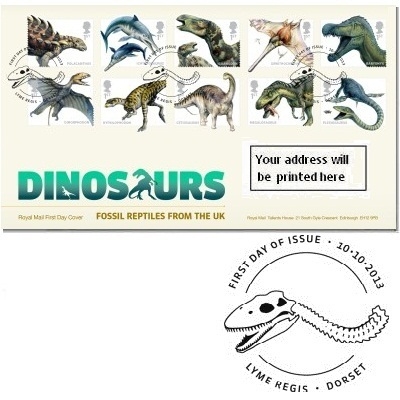
Complete with an informative filler card written by fossil expert Dr
Angela Milner, this striking First Day Cover has all ten Dinosaurs
Stamps affixed. Cancelled with a Lyme Regis postmark, chosen as it was
the site of Mary Anning’s landmark discovery of the Ichthyosaurus.
|

This striking cover features the Special Stamps and a commemorative
medal from The Royal Mint. It also contains an insert card looking at
how discoveries, interpretations and technology have worked together
over the years. Limited Edition of 9,000.
|
|
| Gutter
Pair |
Presentation
Pack |

|

In the glorious Presentation Pack, which includes all ten Special
Stamps, Dr Angela Milner of the Natural History Museum in London
examines our discovery of the Dinosaur age in superb detail. She also
looks at the British pioneers of paleontology and the future of the
science, through a host of facts, photographs and illustrations. |
| Circulated
cover |
|

Register letter sent on the fist day of the stamps issue. |
|
|

|
References
Royal Maii Group
Ofiicial press release of Royal Mail
Norvic Philatelics Blog
Norvic Philatelics
Everything Dinosaur
examiner
IW radio
Driffield Today
Last update 14.12.2017
Any feedback, comments or even complaints
are welcome: admin@paleophilatelie.eu (you
can email me on ENglish, DEutsch, or RUssian)






